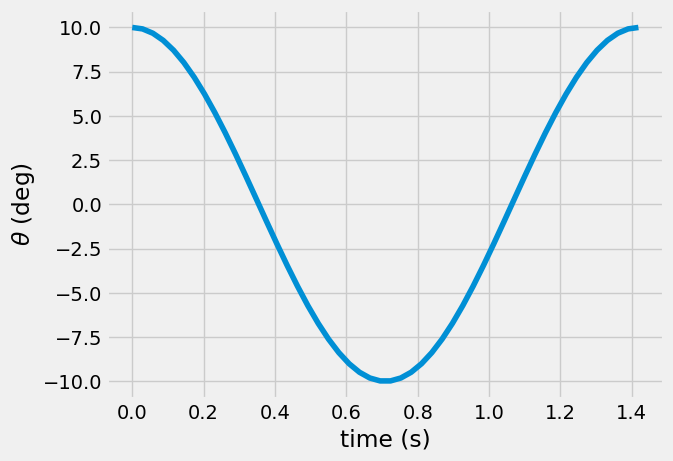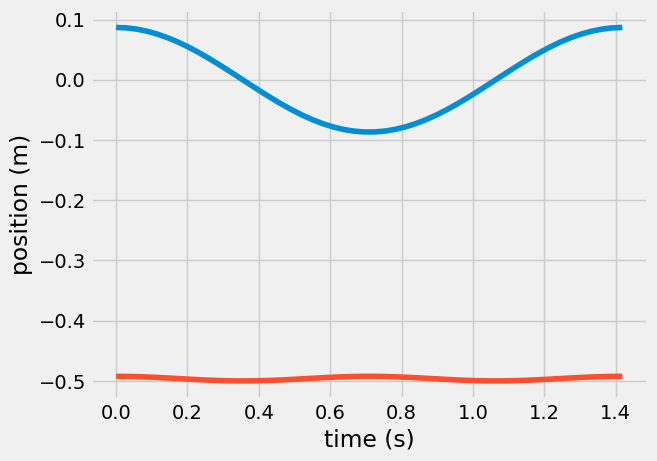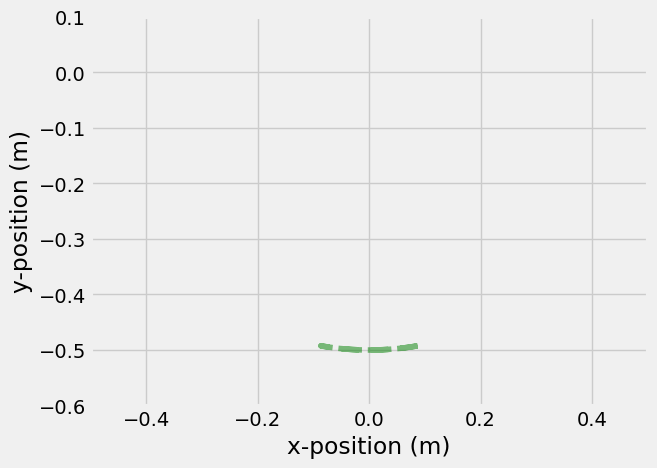Pendulum plotting solution#
A pendulum is another harmonic oscillator, but you have to linearize the equation of motion. The simple pendulum equation of motion is as such
\(\ddot{\theta} = -\frac{g}{L}\sin\theta\)
where \(g\) is acceleration due to gravity and \(L\) is the length of the pendulum.
Linearize equation of motion#
You can’t integrate this equation of motion, so you can take a Taylor series expansion
\(\sin\theta = \theta - \frac{\theta^3}{3!} + \frac{\theta^5}{5!} + ...\)
Now, you can use the first term in the series to create the harmonic oscillator equation
\(\ddot{\theta} = -\omega^2 \theta = -\frac{g}{L} \theta\)
where \(\omega = \sqrt{\frac{g}{L}}\).
You can see how these Taylor series terms diverge from the actual \(\sin\) function below.

Plot the solution for the linearized simple pendulum#
The solution to the harmonic oscillator is given as such
\(\theta(t) = \theta_0 \cos\omega t + \frac{\dot{\theta}_0}{\omega}\sin\omega t\)
where \(\theta_0\) is the initial angle of the pendulum and \(\dot{\theta}_0\) is the initial angular velocity of the pendulum (+ counter-clockwise/ - clockwise motion).
Below, you plot the solution for 1 period of motion for a L = 0.5-m pendulum released from rest at \(\theta_0 = 10^o = \frac{\pi}{18}~rad\).
Note: the time period, \(T=\frac{2\pi}{\omega}~s\) is the time for to move right-to-left, then left-to-right, to its initial position.
L = 0.5 # m
w = np.sqrt(9.81/L)
t = np.linspace(0, 2*np.pi/w)
theta = np.pi/18*np.cos(w*t)
plt.plot(t, theta*180/np.pi)
plt.xlabel('time (s)')
plt.ylabel(r'$\theta$ (deg)')
Text(0, 0.5, '$\\theta$ (deg)')

Motion of the pendulum#
The solution plotted above is the orientation of the pendulum. The position of the mass is
\(\mathbf{r} = L\hat{e}_r = L(\sin\theta \hat{i} - \cos\theta \hat{j})\)
where \(\theta = \theta(t)\) that you created above. Below, you plot the x- and y- positions of the simple pendulum.
r = L*np.vstack([np.sin(theta), -np.cos(theta)])
plt.plot(t, r[0,:], label = 'x-location')
plt.plot(t, r[1,:], label = 'y-location')
plt.xlabel('time (s)')
plt.ylabel('position (m)')
Text(0, 0.5, 'position (m)')

Note: Notice how the x-position has a similar shape to the solution for \(\theta(t)\), but the y-position has very little variation. The angle \(\theta\) is small, \(\theta<<1\), so you can approximate the position as
\(\mathbf{r} = L(\sin\theta \hat{i} - \cos\theta \hat{j}) \approx L\theta\hat{i} - L\hat{j}\)
because the Taylor series expansion for \(\cos(\theta)\) is
\(\cos\theta = 1 - \frac{x^2}{2!} + \frac{x^4}{4!} + ...\)
so you can approximate \(\cos\theta \approx 1\).
Animation of the pendulum motion#
Here, you can see how the pendulum swings. It starts at \(\theta_0=10^o\) and swings left to \(\theta(t=T/2)=-10^o\). In this simple pendulum model, you did not include any effects of air resistance, friction, or damping so the motion will continue to oscillate until acted upon by another system.
---------------------------------------------------------------------------
RuntimeError Traceback (most recent call last)
Cell In[6], line 34
28 return (line1, )
30 anim = animation.FuncAnimation(fig, animate, init_func=init,
31 frames=range(0,len(t)), interval=50,
32 blit=True)
---> 34 HTML(anim.to_html5_video())
File /opt/hostedtoolcache/Python/3.9.23/x64/lib/python3.9/site-packages/matplotlib/animation.py:1265, in Animation.to_html5_video(self, embed_limit)
1262 path = Path(tmpdir, "temp.m4v")
1263 # We create a writer manually so that we can get the
1264 # appropriate size for the tag
-> 1265 Writer = writers[mpl.rcParams['animation.writer']]
1266 writer = Writer(codec='h264',
1267 bitrate=mpl.rcParams['animation.bitrate'],
1268 fps=1000. / self._interval)
1269 self.save(str(path), writer=writer)
File /opt/hostedtoolcache/Python/3.9.23/x64/lib/python3.9/site-packages/matplotlib/animation.py:128, in MovieWriterRegistry.__getitem__(self, name)
126 if self.is_available(name):
127 return self._registered[name]
--> 128 raise RuntimeError(f"Requested MovieWriter ({name}) not available")
RuntimeError: Requested MovieWriter (ffmpeg) not available

Wrapping up#
In this notebook, you plotted the solution for a simple pendulum and used the kinematic definitions to plot the motion of the pendulum.


